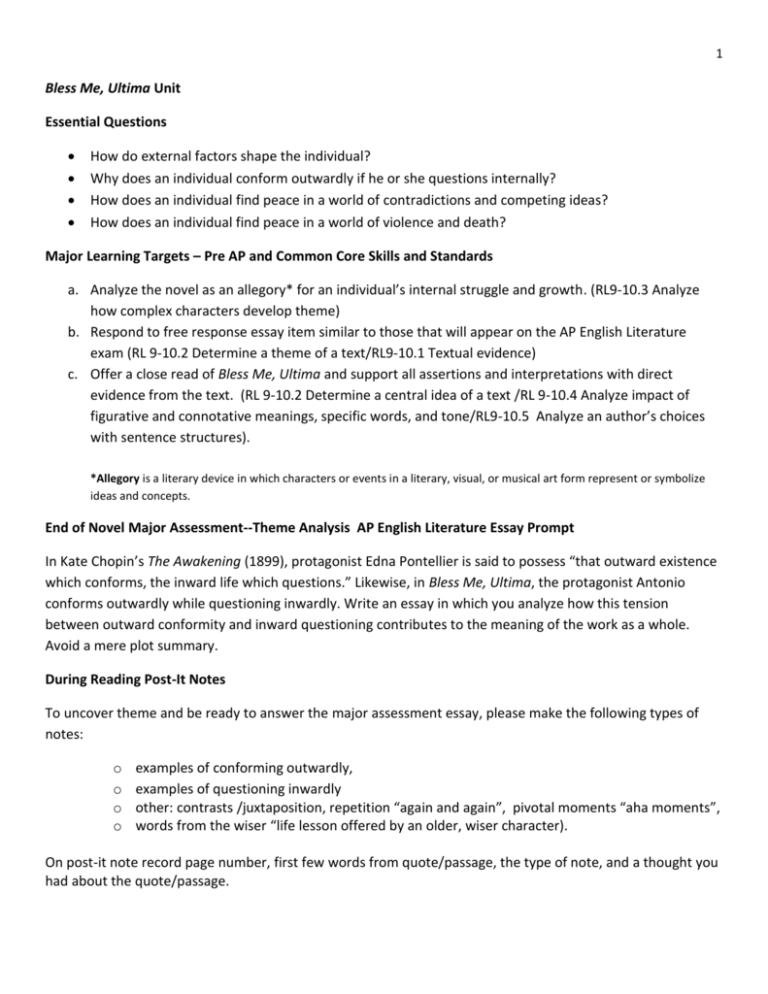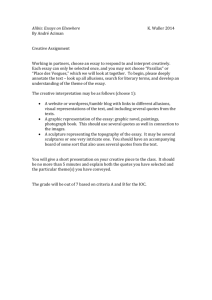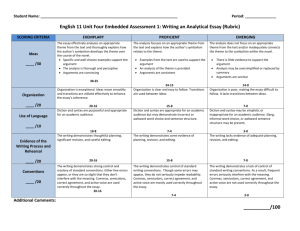Bless Me, Ultima Unit Plan 2015
advertisement

1 Bless Me, Ultima Unit Essential Questions How do external factors shape the individual? Why does an individual conform outwardly if he or she questions internally? How does an individual find peace in a world of contradictions and competing ideas? How does an individual find peace in a world of violence and death? Major Learning Targets – Pre AP and Common Core Skills and Standards a. Analyze the novel as an allegory* for an individual’s internal struggle and growth. (RL9-10.3 Analyze how complex characters develop theme) b. Respond to free response essay item similar to those that will appear on the AP English Literature exam (RL 9-10.2 Determine a theme of a text/RL9-10.1 Textual evidence) c. Offer a close read of Bless Me, Ultima and support all assertions and interpretations with direct evidence from the text. (RL 9-10.2 Determine a central idea of a text /RL 9-10.4 Analyze impact of figurative and connotative meanings, specific words, and tone/RL9-10.5 Analyze an author’s choices with sentence structures). *Allegory is a literary device in which characters or events in a literary, visual, or musical art form represent or symbolize ideas and concepts. End of Novel Major Assessment--Theme Analysis AP English Literature Essay Prompt In Kate Chopin’s The Awakening (1899), protagonist Edna Pontellier is said to possess “that outward existence which conforms, the inward life which questions.” Likewise, in Bless Me, Ultima, the protagonist Antonio conforms outwardly while questioning inwardly. Write an essay in which you analyze how this tension between outward conformity and inward questioning contributes to the meaning of the work as a whole. Avoid a mere plot summary. During Reading Post-It Notes To uncover theme and be ready to answer the major assessment essay, please make the following types of notes: o o o o examples of conforming outwardly, examples of questioning inwardly other: contrasts /juxtaposition, repetition “again and again”, pivotal moments “aha moments”, words from the wiser “life lesson offered by an older, wiser character). On post-it note record page number, first few words from quote/passage, the type of note, and a thought you had about the quote/passage. 2 Other Assessments and Activities 1. Reading Response Entries 2. Reading Check Assessments (This means you will have a quiz/assessment with no warning over your reading) 3. Passage Analysis Presentations 4. Passage Analysis Constructed Responses and/or Graphic Organizers (How FIDDS contributes to tone or meaning?) 5. Small and whole group discussions-conversational roundtables, mystery envelops, and/or Socratic seminars Reading Section Schedule Chapters 1-8 (Uno-Ocho) Due Thursday, October 8 Chapters 9-12 (Nueve-Doce) Due Thursday, October 12 Chapters 13-17 (Trece-Diecisiete) Due Wednesday, October 21 Chapter 18-22 (Dieceiocho-Veintidos) Due Tuesday, October 27 Also notes the following study tips: On my website, you will find the following study aids: character lists, symbol lists, study guide questions, and Spanish to English translations for novel. ***The best details and quotes for your essay will be from the whole novel and will be more than just pieces of dialogue between two characters. Details and quotes that are mostly from dialogue reveal “quick” rather than close reading.*** 3 Bless Me, Ultima by Rudolfo Anaya End of Novel Pre-AP Theme Analysis Essay Assessment – Final draft 100 points (More points will be given for writing process items) In Kate Chopin’s The Awakening (1899), protagonist Edna Pontellier is said to possess “that outward existence which conforms, the inward life which questions.” Likewise, in Bless Me, Ultima, the protagonist Antonio conforms outwardly while questioning inwardly. Write an essay in which you analyze how this tension between outward conformity and inward questioning contributes to the meaning of the work as a whole. Avoid a mere plot summary. Prewriting Please select one or more of the following before you begin outlining: brainstorming, listing, clustering, charting, or freewriting. Use this space provided or a separate sheet of paper. 4 Outline Template Thesis (include universal theme statement): Body Paragraph #1 Topic Sentence - Supporting Details: Body Paragraph #2 Topic Sentence - Supporting Details: 5 Body Paragraph #3 Topic Sentence - Supporting Details: Optional: Body Paragraph #4 Topic Sentence - Supporting Details: Concluding Thesis (with universal theme statement) restated in other words 6 Pre-AP Literary Analysis Scoring Guide 1) Ideas: 9-8 Significant and insightful understanding of the text, its style, and the essay question I can perceptively and insightfully determine an ironic meaning or theme based on its development over the course of the text. 2) I can determine a meaning or theme with some insight based on details pulled from the entire text. 5 Completes the task and shows an understanding of the question but does so on a superficial level; states the obvious. I can accurately determine an obvious meaning or theme based on the majority of the text. 4-3 Misses important ideas in the text and/or summarizes or paraphrases the text’s ideas 2-1 Minimal understanding of the topic or the text, resulting in frequent misinterpretations I can determine a general or obvious meaning or theme of a text based on part of the text. I do not determine a clear meaning or theme of a text OR OR I may accurately summarize the passage’s meaning or theme instead of interpreting a meaning or theme. I provide a meaning or theme that shows that I did not understand or read the text. Development A – Evidence/Quote Choices 9-8 Evidence is strong, persuasive, and abundant. Quotes and details demonstrate attention to more difficult or less obvious parts of text 3) 7-6 Completes the task of the essay; some insights; less clarity and precision than a 9-8 7-6 Evidence is mostly persuasive and abundant. Quotes and details occasionally demonstrate attention to more difficult or less obvious parts of text 5 Evidence lacks depth. Quotes and details demonstrate attention to easier or more obvious parts of text. 4-3 Evidence used lacks clarity and/or accuracy or is not used well to develop assertions. Quotes and details demonstrate attention to easier or more obvious parts of text and a superficial reading, perhaps reading out of context. 2-1 Little evidence is provided. Quotes and details are minimal and demonstrate little reading of the text. Development B – Explanations Evidence/Quote Choices and Relationship to Theme/Thesis 9-8 All evidence from the text is followed by the writer’s clear explanations relating quotes/details to the thesis and showing the relationship of chosen details/quotes to one another. 7-6 Most evidence from the text is followed by the writer’s clear explanations relating quotes/details to the thesis. 5 Some evidence from the text is followed by the writer’s explanations sometimes relating quotes/details to the thesis. 4-3 Some evidence from the text is followed by the writer’s explanations, but the explanations are unclear or do not relate back to the thesis. 2-1 Evidence has little writer explanation following it. 7 4) Organization: 9-8 Sound, organic organization growing from the writer’s purpose with thematic and topical transitional phrases. 5) 7-6 Sound organization with thematic and topical transitional phrases. 5 Adequate and clear organization with predictable transition words and phrases. 4-3 Somewhat clear organization with predictable transition words and phrases; reader may be lost in some parts. 2-1 Unclear organization; little to no transitional phrases or words 5 Adequate diction and syntax. More errors but understanding of ideas while reading is clear in most parts of essay. 4-3 Inconsistent control of diction and syntax. Errors impede understanding for the reader throughout the most of the essay. 2-1 Diction is inaccurate, and syntax is simplistic. Errors impede understanding for the reader throughout all of the essay. Style and Correctness 9-8 Articulate diction and syntactic variety for effect. Error-free and reading is entirely smooth for the reader. 7-6 Accurately used diction and syntax; lacks sophistication of 9-8. Few errors and reading is mostly smooth for the reader. AP Literary Analysis Scoring Scale 8-9=Significant understanding; well-developed; organized; stylistically mature 9=100-97% 8=96-90% 6-7=some insights; not as precise or developed as 8-9; generally well-written with some lapses in structure, sentence structure, or word choice 7=89-86% 6=85-80% 5= adequate understanding of question but obvious or literal; writing may be formulaic or underdeveloped in parts; acceptable writing style but fairly simple 5=79-75% 3-4=relies on paraphrase or summary rather than complex interpretation; may demonstrate misunderstandings; underdeveloped in most parts of the essay; may miss parts of the text; grammar mistakes may impede understanding 4=74-70% 3=69-60% 1-2=incomplete response and interpretation; little understanding of the topic; does not address question or assignment accurately 2=59-50% Comments and writing goal: 1=49% and below 8 STUDENT WRITER TROUBLESPOTS Content of Literary Analysis Thesis/theme needed clarity. OR Thesis/theme stated obvious/seemed like summary rather than interpretation and inference. (see theme statement handout) Organization needed transitioning. OR Organization needed a clearer flow of ideas. Major or significant details from the text inadequately addressed, incorrectly addressed, or not addressed. Details not smoothly introduced: the “I” of “IRE.” Quotes seem to be “dropped” or inserted without a clear set-up of the issue or point to be addressed. “E” of “IRE” does not relate back to the thesis in some parts. OR “E” of “IRE” does not explain key words or phrases from the quote or “R” to show how you interpreted the line as you did. Detail selection does not reflect a thoughtful consideration of the WHOLE novel. Details from only a couple of places and not from end. Details selection are obvious and/or mostly from character dialogue. Student’s Style Wordiness in some sentences Word(s) used incorrectly Sentences contain multiple punctuation, grammar, and mechanics errors. Sentences lack variety or seem choppy. Repetitive ideas or word choice (and not for literary effect or coherence) Lack of clarity when explaining ideas in A) introduction B) body paragraphs C) conclusion Tone of essay seems inappropriate. Verb tenses shift and/or pronouns shift making the reading confusing. Introduction and conclusion are simplistic and lack voice/style. Introduction and conclusion do not have author, title, thesis statements, or necessary background information. 9






